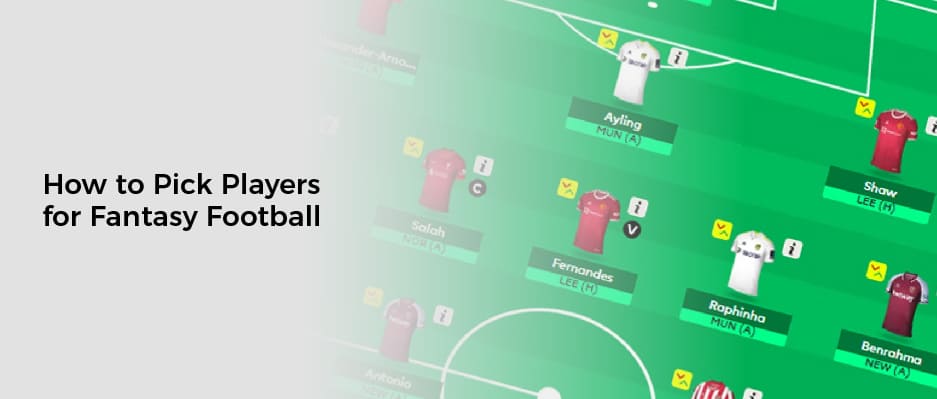How to Pick Players for Fantasy Football: There are several things you should consider when picking players for your fantasy football team. First, you should consider talent and role. For example, a shaky veteran WR5 is not as valuable as a young RB4 who might get a few big touches. You should also look at a player’s college performance.
The Best Way to Pick Fantasy Football Players
Drafting Running Backs
The draft process is different for each league. Whether you choose to draft running backs in your first or second round will depend on the number of positions available and the ADP (average draft position). The first two rounds are the best time to draft running backs, as they are flying off the shelves. After that, they start to fade in value and become less desirable.
Running backs can be a good pick for your team, especially if you are drafting for a deeper league. There will be a handful of elite RBs every year, but they are usually the first players taken in a draft. If you happen to get one of these players, consider yourself fortunate.
When selecting a running back for your fantasy football team, make sure to take a positional backup. RBs have more volatility and injuries than any other position, so you need to have positional depth. Your RBs should be a mix of studs, sleepers, rookies, and breakouts.
If you’re looking for a sleeper RB, make sure to pick someone with upside. For example, if you have a Zero-RB league, you may want to draft Deebo Samuel or Jacobs in the second round. They are both solid running backs with solid upside. However, they are also risky to own, which is why they’re better suited as RB2s and RB3s.
Drafting Wide Receivers
Wide receivers are the second most popular position to draft in a fantasy football league. The best wide receivers typically rank in the top ten in total fantasy points for their position. Wide receivers also tend to have longer careers than running backs, so they are more reliable and safer to draft. Owners often employ the WR/WR strategy, especially in points-per-reception leagues.
Wide receivers are an important part of the offense, so they should be considered during the draft, especially in the first round. If you’re drafting a receiver out of the first round, make sure you don’t draft the second or third receiver at his position. Instead, look for a receiver that is projected to score similar numbers to the top wide receivers in the third and fourth rounds. Those players include Amari Cooper, Stefon Diggs, Larry Fitzgerald, and Nelson Agholor.
If you’re looking for value, consider drafting a wide receiver tied to a quarterback. While most fantasy owners tend to spend their first-round draft capital on running backs, there’s no reason you can’t target a wide receiver tied to your fantasy QB1 (and vice-versa).
WR2s and WR3s are the best value in tier four but don’t overpay. These players may be the back-end starters or top-end bench pieces. These players have the potential to become WR1s in a few seasons, but their ADPs may not reflect that potential.
Drafting IDPs
Drafting IDPs in fantasy football can be tricky, especially if you have no experience with them. However, there are several key factors that you should consider before drafting them. For starters, you need to know where you’re likely to find a top-tier IDP. You can use projections to decide where to draft an IDP based on projected scoring.
Knowing the defensive scheme is essential when selecting an IDP. You will want to find a linebacker who can play “three downs” because these players will likely be able to provide higher fantasy production. You should also choose safeties over cornerbacks, as they’re more likely to provide tackles on a weekly basis. Moreover, safeties are always a good choice for IDPs, as their presence in the secondary means more tackles.
In IDP leagues, you should be aware of the fact that tackles and sacks are worth more than tackles and yardage. These factors will help you determine how valuable an IDP is compared to his offensive counterparts. Offensive players’ value will vary, but tackles and interceptions are the two most important categories that should be looked at in an IDP league.
Drafting Kickers
You have to know when to draft kickers for fantasy football. The best time to draft kickers is during the last round of the draft. This is because kickers are constantly being swapped out by other teams. It is important to choose a kicker that fits the role you have in mind, otherwise, you may have to settle for someone you might not have liked.
When you draft kickers, make sure you choose ones that play indoors and in an offense capable of scoring points. You should also avoid taking a kicker in the third or fourth round because he might end up costing more points than any other position. If the offense is mediocre, then you should consider dropping him during the bye week. In addition, it is not a good idea to draft a kicker in the first round if the team’s offense is weak.
A kicker can make or break your fantasy football team. Even if you’re playing a team that struggles to score points, one bad kick can mean three points for the kicker. This is why many fantasy football owners rotate kickers throughout the season. This strategy is known as “streaming.”
Drafting Defense
Drafting defense players is a tough decision, but there are a few key things you should keep in mind. For starters, defenses play a crucial role in determining fantasy matchups, so you should try to fill out your starting offense before considering drafting a defensive player. For instance, if you have two WRs, you should wait to draft a third defensive player until you are confident that your starting offense is deep enough.
Read Also: How to Pay for UFC 264
Defensive players produce most of their value through tackles, just like offensive players. While tackles don’t matter much in IDP leagues, tackles are a good way to solidify a player’s value. Also, defensive players can be found as early as the sixth or seventh round in some leagues.
While many traditional fantasy football owners shrug their shoulders at the concept of drafting defensive players, IDP leagues have made it possible for fantasy football players to pick their favorite defensive players. Moreover, these players can work in a variety of formats, such as team defense or special teams. However, IDP leagues also require more effort and dedication than standard leagues.



